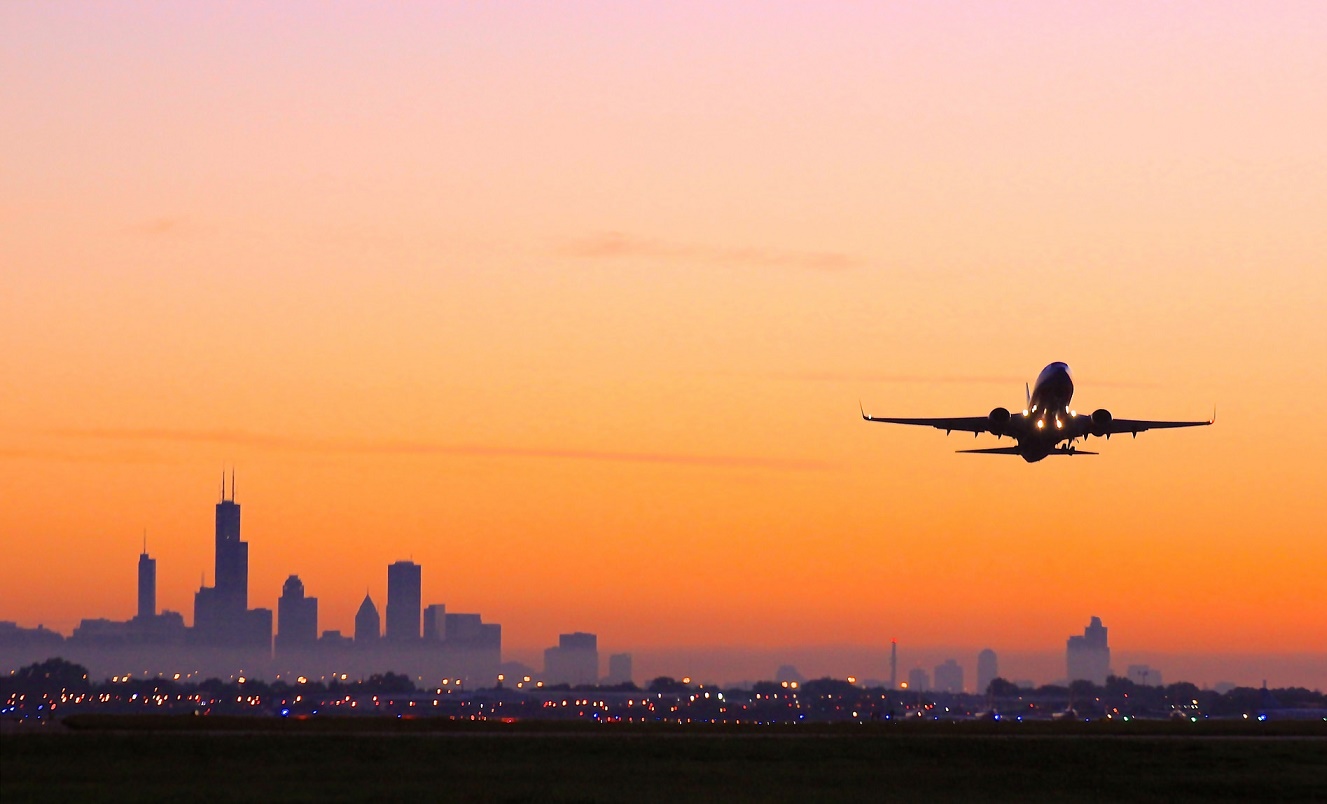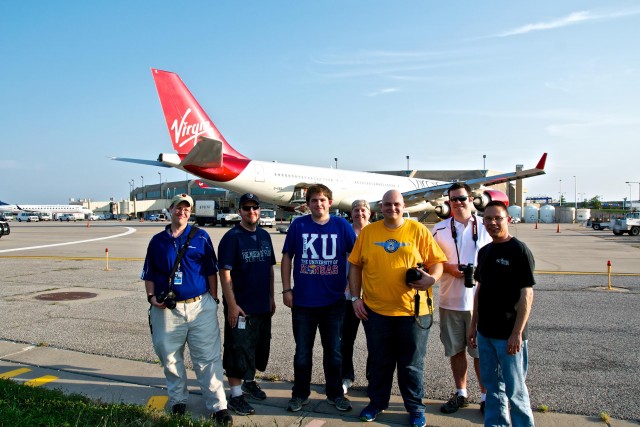
Aviation enthusiasts pose with a Virgin Atlantic A340 – Photo: Daniel Palen
As an avid plane spotter, I’ve had my fair share of run-ins with the curious/uninformed public, skeptic law enforcement officers (LEOs), airport staff, and even airline employees. Typically these exchanges go positively and, with luck, without missing out on any good shots: “Who are you? What are you doing? Why are you taking photos in a post-9/11 world?” To which I respond: JL Johnson, frequent traveler, airline reporter, and, most importantly: AvGeek.
Typically I tell them about my passion and how [whatever organization they represent] is generally supportive (or at least tolerant) of such activity. It’s not uncommon that I pull out an iDevice and show the inquirer samples of my work and/or tweets endorsing or acknowledging spotting from various institutions (I keep a list of tweets handy for this very reason – you should too).
While doing homework on the environment in advance of spotting is key, I find that the more geeky and passionate I make the conversation the quicker a situation is defused. Apparently geeks can’t be bad guys. For whatever reason, people respond better not to fact, but passion/emotion. So I bring both.
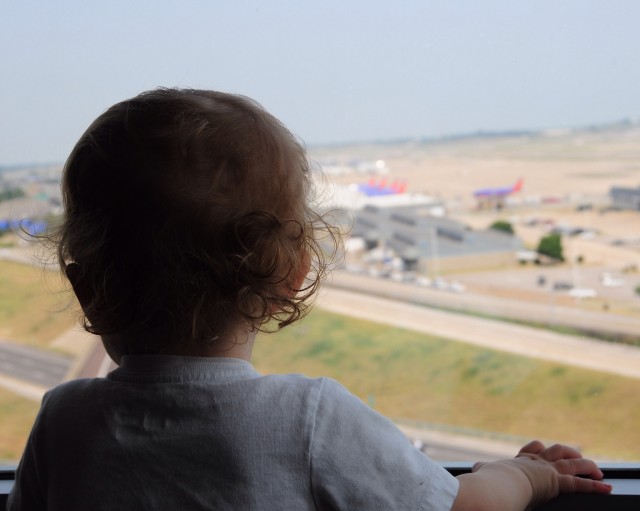
Plane spotting – even toddlers do it! Photo: JL Johnson
That’s the typical interaction. Alas, my attempts to convince folks that I’m not a terrorist and that my telephoto lens doesn’t shoot plane-crippling ray-gun beams are not always successful. I had one such interaction recently at Chicago’s Midway Airport (MDW) which I’d like to detail if only to clear the air about what’s generally allowed vs. not, how to handle these encounters, and to assure my AvGeek brethren that it’s typically OK to take photos of publicly-visible property from public areas. But…your results may vary.
Midway Airport just doesn’t get the love it deserves. Whenever there’s discussion of plane spotting in Chicago, it’s always assumed that O’Hare is the venue, and that’s just not right. Sure, as a dedicated Southwest Airlines A-Lister, Midway is the one-and-only Chicago airport that’s deserving of my regular (and frequent) business. But setting loyalties aside for a moment, the spotting at Midway is quite simply excellent for any and all, even the hard-to-please “legacy lovers” who stalk United and American at ORD.
Why? Well, the opportunity for incredible photos like the one above should be enough, but if you aren’t convinced, read further’¦
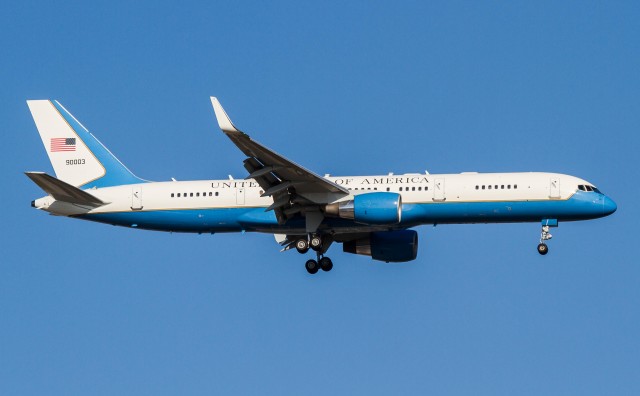
US Secretary of State John Kerry arrives at the G20 in Brisbane aboard a C-32
The annual G20 (group of twenty) Summit is the gathering of the world’s 20 most powerful and influential nations to discuss various political and economic issues facing the world. As with any gathering of major international powers, there was a vast array of interesting and unique aircraft on show.
This year’s summit was held in Brisbane, Australia, during the weekend from November 14th – 16th. As I was in Brisbane during this time, I was very fortunate to partake in some good old plane-spotting.
Over 40 aircraft part took in the G20 Summit; this ranged not only from the various head of state VIP aircraft but also the countless support aircraft. These aircraft carried everything from advance teams to motorcade vehicles, right through to food for the various world leaders and dignitaries attending the summit.
Additionally, the US delegation also brought with them a number of helicopters including “Marine One” and V-22 Ospreys to assist in the transfer of POTUS from the military base where he landed into the city.
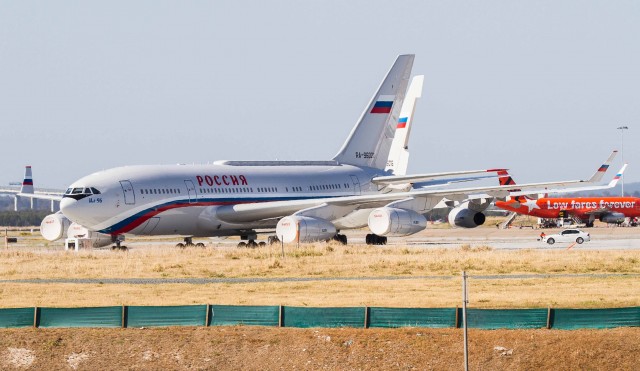
The dedicated media/spotters area for the event allowed for some great views of the three IL-96 aircraft from the Russian delegation
As with any major event of this nature security was very tight. There were over 6,000 additional police on duty for the weekend. Now, most would expect that the airport would be completely off-limits to spotters. But thanks to some outstanding work by the local plane-spotting community, in particular the work of YBBN Spotters Group together with Brisbane Airport Corporation (BAC), there was a dedicated area set up on airport property for registered spotters and media.
Unfortunately, due to the prevailing winds and runway configuration, the area was only really suitable for afternoon and evening movements. Even so, there was plenty of other locations off-airport to get some spectacular images.
Below is a selection of images that I have taken during the event showcasing the vast array of different and unique aircraft used for the event by the various visiting nations. Unfortunately, due to the timings of some arrivals, it was not possible for me to capture all of the visiting aircraft, but I feel I was able to capture quite a few special aircraft.
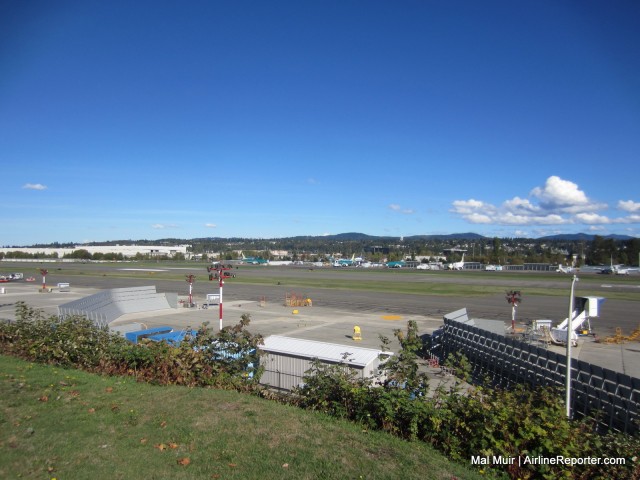
Renton Municipal Airport, home of the Boeing 737
In the past, we have featured plane spotting guides for Paine Field and also other airports like Anchorage or Tokyo Haneda. With numerous airports in the Seattle area, including SeaTac and Boeing Field, there is sometimes a forgotten, but quite important, airport for plane spotters which provides a continuous stream of aircraft to spot. I am speaking of Renton Municipal Airport, the home of Boeing’s narrow-body aircraft plant.
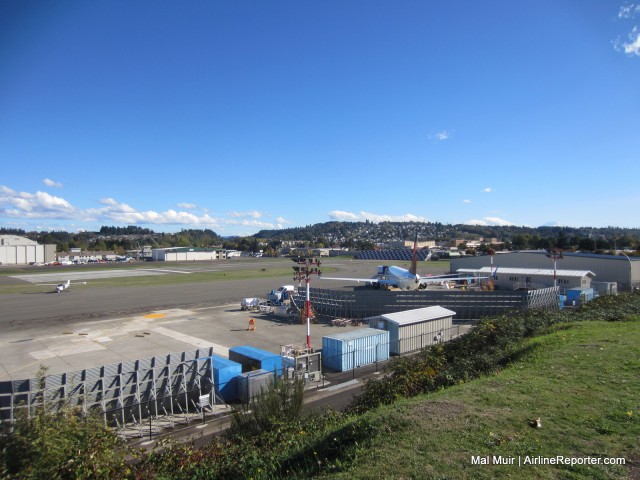
The southern threshold of Renton’s runway
The Renton Airport traces its history back to World War II. Originally built on reclaimed land from Lake Washington, the airport was built by the Department of Defense (DoD) to support Amphibious Aircraft being built by Boeing on Lake Washington. The PBB Sea Ranger project was cancelled after the prototype was built, so Boeing ended up using the facility to produce the B-29 Superfortress. By the end of the war, a total of 1,119 were built.
After the war, the City of Renton purchased the airport back from the DoD for $1 and the facility laid dormant for a few years. In 1948, the KC-97 Stratofreighter project brought the airport back to life and thus began a long and productive history of aircraft to flow out of the Boeing factory doors. The first Dash 80 aircraft, famous for the barrel roll over Lake Washington, rolled out in May 1954. Renton was the home of every single 707 built.
The 727 & 757 were all built there as well. However, Renton is famous these days for being the home of the 737, where production stands at a massive 42 aircraft per month.
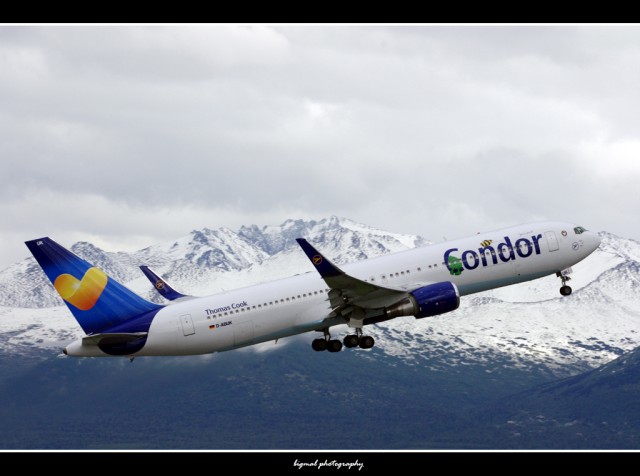
A Condor 767-300ER departing Anchorage Airport – Photo: Mal Muir | AirlineReporter
Back in May I was desperate to fly somewhere — anywhere. By that time, I had not flown a single mile. Yep that’s right, an AvGeek who flew over 60,000 miles last year alone was sitting at 0 miles until May. I was having major withdrawals and then I saw a fare sale to Alaska.
Last year, during my $100 Challenge, I decided on Kansas City over Alaska. I was determined to tick that missing state off my list, and $200 round trip fares to Anchorage were a steal! So I booked my trip and decided on a weekend of pure plane spotting.
I had heard, read, and seen how good spotting at Anchorage can be and I wanted to check it out myself. The airport sits in view of a massive mountain range providing a great back drop to the aircraft taking off and landing. Adding to the scenic nature of the airport is the fact that it is the crossroads of freight aircraft going between Asia and the Americas. What AvGeek wouldn’t want to spot there?


